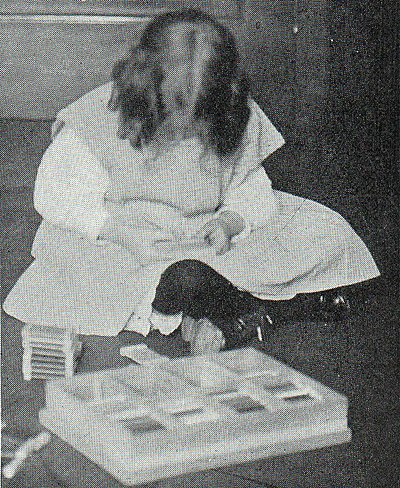Why the Children Are Often Blindfolded: How many of us think why, when we say “let me see,” we are apt to close our eyes? Our mind-image of the thing we are trying to think about is thus made more vivid by shutting away from it all competitive images; and there are other reasons. Accordingly a good many things in a Montessori school are done by the children while blindfolded.

|
| © House of Childhood Inc. |
| Hook and Eye Frame |
| Other features of the child's daily business of dressing are taught by means of similar frames. |
Dressing Frames: A set of eight wooden frames. On six of these are mounted pieces of cloth of varying qualities to be joined by means of large buttons and button holes, automatic fasteners, small buttons and button holes, hooks and eyes, colored ribbons for bow tying and lacing through eyelets. Similar frames with leather pieces, similarly stimulate interest in shoe lacing and shoe buttoning. The children thus eagerly learn the use of their hands and usually “discover” for themselves that they can apply this skill in dressing.
FOR DEVELOPING SKILL IN NOTING DIFFERENCES IN DIMENSION, FORM AND NUMBER
The apparatus for developing skill in noting differences in number, form and dimension, include:
Solid Geometrical Insets: Three series of wooden cylinders set in corresponding holes. In the first series, diameter is constant, height varies; in the second series, diameter is constant, height varies; in the third series the cylindrical form alone is constant, height and diameter vary.
With these insets the child, working independently, learns to discriminate objects according to thickness, height and size. (For example, if he places the next-to-the-largest cylinder in the largest hole, he will find himself in the end with the largest cylinder for the smallest hole, etc.). These cylinder sets prepare for the more difficult exercises that follow.
“The Tower:” Consists of ten wooden cubes decreasing regularly in size from 10 centimeters to 1 centimeter. With them the child builds "the tower" and learns general dimension. (This also is self corrective; since a misplaced block breaks the line.)
“The Broad Stair:” Ten rectangular wooden blocks decreasing in height and width, length only being constant. To teach dimension of thickness.
“The Long Stair:” Ten wooden square rods varying only in length; the first one meter long, the last one decimeter long, intervening ones diminishing one decimeter. Being marked off in decimeters, they teach dimension of length, help form habits of accurate classification and are later used in teaching addition, subtraction, multiplication and decimals. (Control of errors is through regularity of decreasing lengths of stairs and alternation of colors.)
Counting Boxes: These are two boxes each with five partitions containing sand paper numbers (on cards) 0 to 9, standing upright in each partition. Under these cards are the corresponding number of counting sticks. These counting sticks succeed the “long stair” in teaching elementary mathematics, the child associating the symbol with the concrete objects.
Counting Case: A case containing cards from which number combinations from 1 to 100 may be made by sliding the numbers into frames arranged perpendicularly in series of five.

|
| © House of Childhood Inc. |
| Learning 64 Shades of Color |
| This illustration shows one of the color boxes and the flat spools upon which the different colored threads are wound. |
